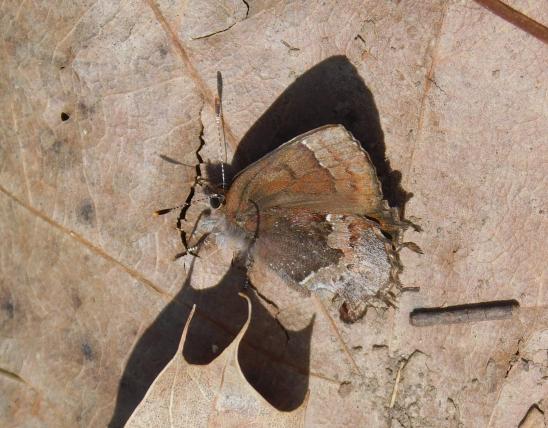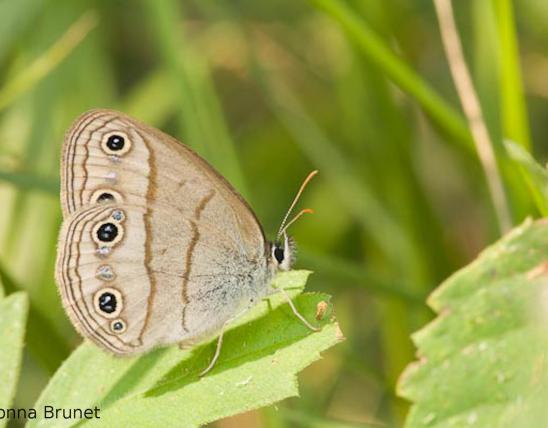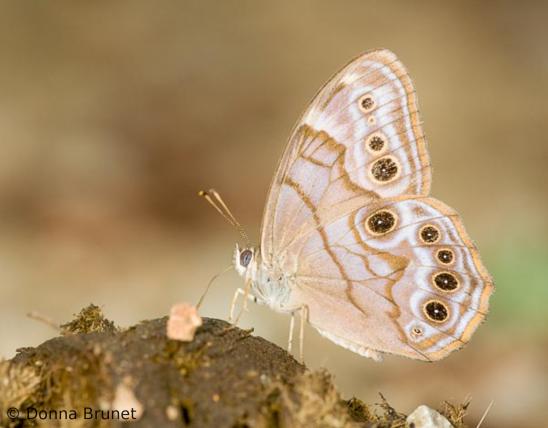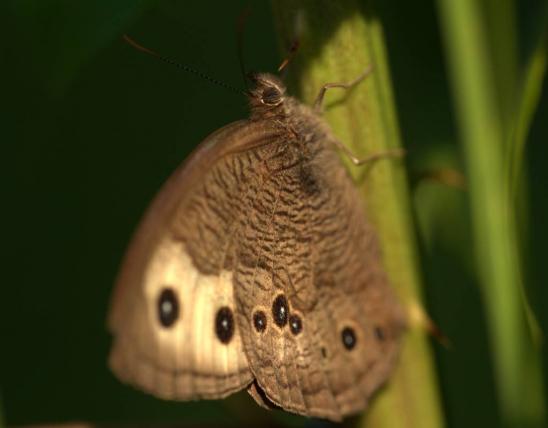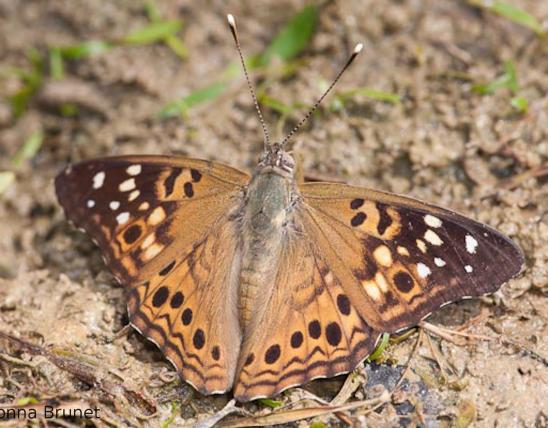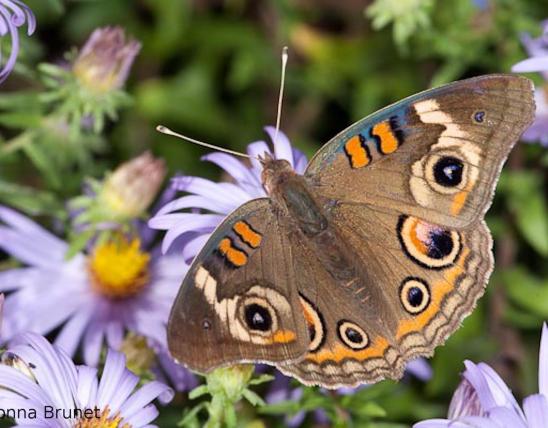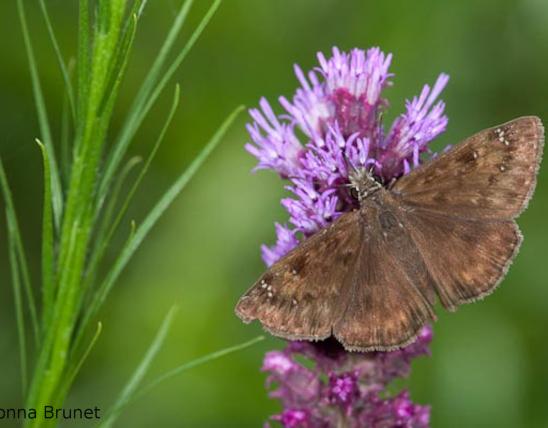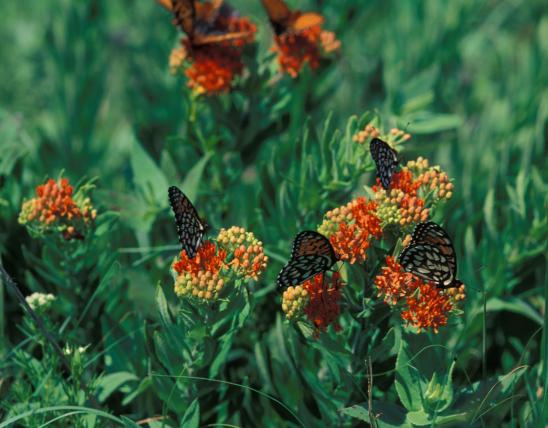
The gemmed satyr is a rather small, brown butterfly that lacks definitive eyespots. It usually perches with the wings closed together above the body. The undersides are somewhat mottled brown and may have a few wavy, darker brown bands. The underside of the hindwing has, on its outer margin, an oval, silvery or grayish patch, usually outlined with a darker brown, that has about 4 small dark spots. These spots may appear as 2 spots thinly divided by a lighter-colored vein. There is usually a white spot inside each dark spot, and the dark spots are often outlined in pale yellow. Some sources describe the spots as highly reflective, but to see it, the light must hit it just right.
The caterpillars are variable in the different broods. They can be grass green (in summer) or tan (in fall), with darker lateral stripes, and have a pair of pronglike tubercles on the head and last abdominal segment. Their streamlined bodies are tapered at both ends.
Similar species: The gemmed satyr is one of several Missouri brushfooted butterflies in subfamily Satyrinae (the satyrs, morphos, and owls). Globally, this subfamily, also called the browns, satyrids, or satyrines, comprises some 2,400 species. As adults, members of this subfamily typically are brown (often with eyespots), have a weak, hopping or skipping flight, live in open woodland habitats, and seldom visit flowers. Instead, they are attracted to tree sap, carrion, and animal droppings. The caterpillars in this subfamily typically eat grasses and are usually dull colored, in shades of green and brown, and have the last abdominal segment forked.
Some other common Missouri satyrids are the little wood satyr, pearly eye, southern pearly eye, and common wood nymph (grayling).
The other members of genus Cyllopsis mostly occur in the New World tropics. Only a few occur in North America north of Mexico, and the gemmed satyr is the only one that occurs in eastern North America. The others live in the southwestern United States.
Wingspan: about 1–1½ inches.
Mostly in the southern half of the state. The range may be shifting northward with climate change. The overall range is in the southeastern United States, north into southern Ohio and Indiana, west into eastern Kansas, Oklahoma, and Texas, and extending southwest into northeastern Mexico.
Habitat and Conservation
Occurs in scattered colonies in woodlands in southern Missouri. The jerking, dodging flight of this small species, as it flutters around in the brushy localities it frequents, makes it a difficult insect to capture or identify.
The caterpillars rest at the bases of their food plants (grasses) during the day; they venture upward to feed at night.
Food
As with most other satyrs, the caterpillars eat grasses. They feed mostly at night. Bermuda grass (Cynodon dactylon), a widespread nonnative/introduced turf grass used in lawns and sports fields, and often considered an invasive weed, is often listed as a notable food plant. Despite its common name, Bermuda grass is native to the Old World, not to the Americas. Since the gemmed satyr is native to our continent and Bermuda grass is not, the butterfly clearly must eat many other grasses as well.
Adults rarely, if ever, visit flowers. They are drawn to sugar bait (which butterfly enthusiasts set out to attract specimens), and they also feed on tree sap and decaying fruit.
Status
Resident species with three broods.
Life Cycle
There are three broods (generations) annually in Missouri. One of our earliest appearing butterflies in spring. Adults are found from early April into September. Males patrol for females. They overwinter as fourth-stage caterpillars.
Human Connections
If you visit a public butterfly house, you are likely to see some tropical relatives of satyr butterflies. In addition to the browns, pearly-eyes, and satyrs, the subfamily Satyrinae also includes groups of butterflies called morphos and owls. Some of these tropical satyrids are mainstays at butterfly zoos. Morpho butterflies (genus Morpho) comprise about 30 species, with nearly 150 subspecies of typically shiny, sky blue butterflies. Owl butterflies (genus Caligo) are typically huge, bark-camouflaged brown butterflies with enormous eyespots on the hindwing undersides (they look like owl eyes); there are about 20 species. Morpho and owl butterflies are incredibly photogenic.
Everyone loves to get back outdoors when winter is over! This is one of the earliest butterflies to appear in spring, so keep an eye out for it. Other butterflies to watch for in April include the spring azure, Henry’s elfin, cobweb skipper, falcate orangetip, and eastern tiger swallowtail. April-appearing moths include the grapevine epimenis, hummingbird clearwing, and snowberry clearwing.
Ecosystem Connections
The frosted oval patch with its contrasting black spots apparently functions as a defense against potential predators. Some observers have suggested these mimic the four big, shiny, goggle-like eyes of jumping spiders (especially the tan jumping spider, Platycriptus undatus, which occurs in about the same range). Several potential predators would think twice before attacking a jumping spider.
Also, the placement of this gemlike patch, at the outer part of the hindwings, must surely draw a predator’s attention away from the head and body of this butterfly, just as the false antennae on the hindwings of hairstreak butterflies do. When it comes to the deadly pecks of a bird, a butterfly’s hindwings are much more expendable than its head. Indeed, older, worn individuals of this species often have the outer parts of the hindwings missing.
Many migratory birds start appearing in Missouri in April, and these early spring butterflies no doubt often become food for them. Biologists have pointed out that a main reason why birds migrate is so they can rear their young in places where insects are plentiful. Birds require insects during breeding season for the extra protein they provide.
























